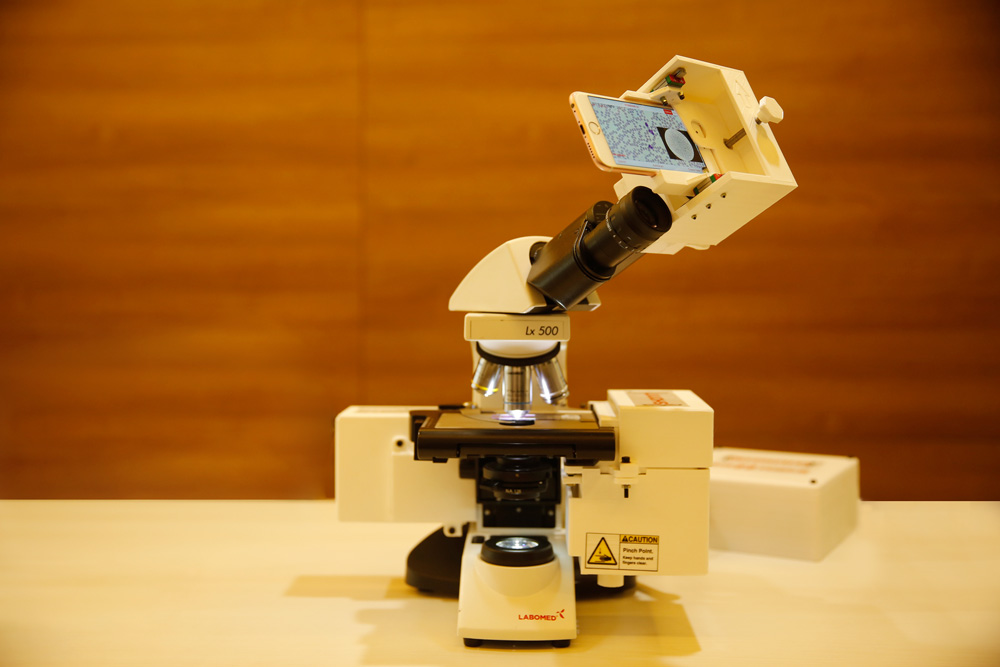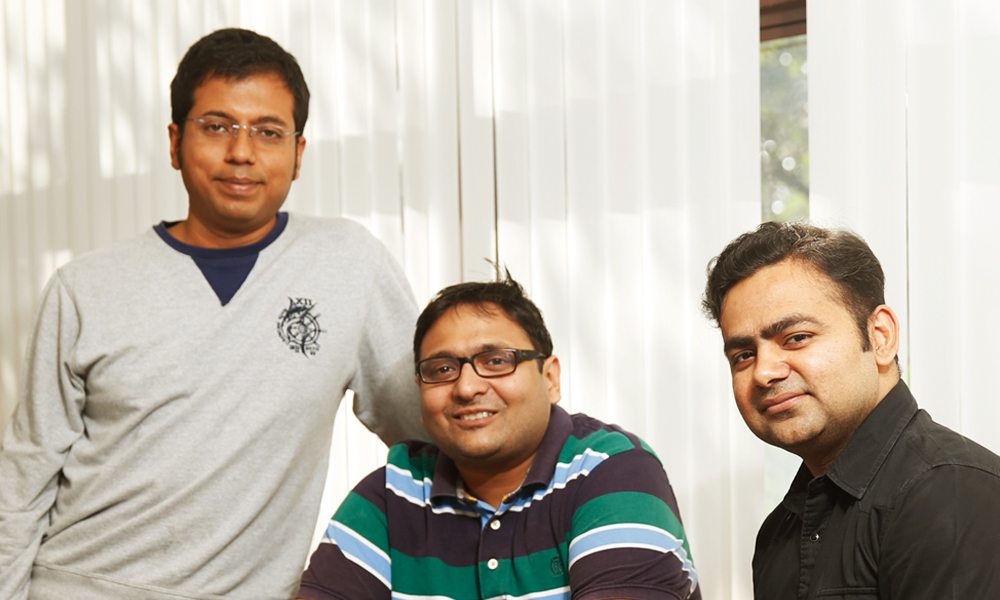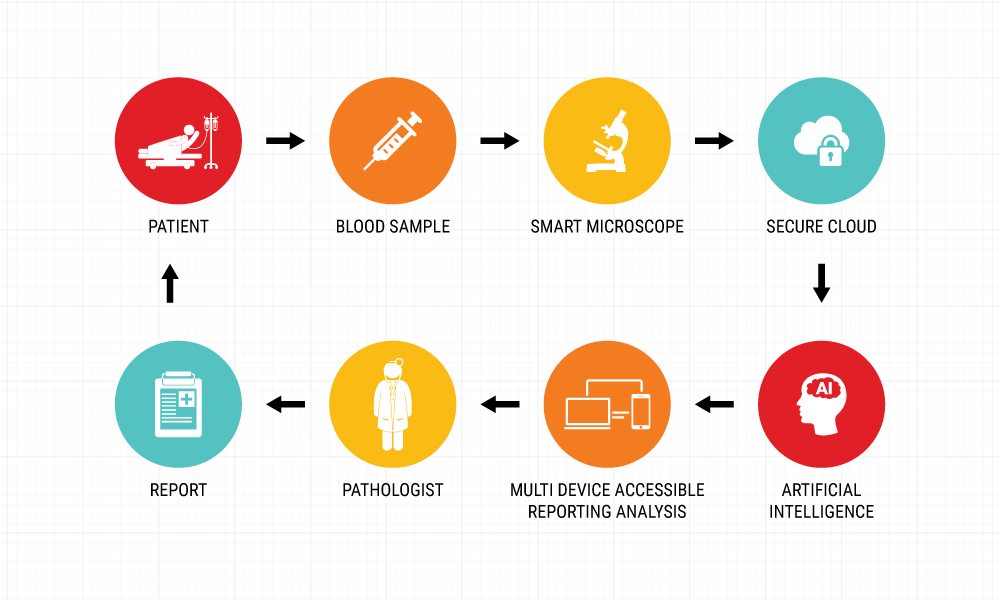As a haematologist (physicians who specialise in the diagnosis, treatment and prevention of diseases related to blood), Dr Preethi Chari interprets art for a living. Her canvas is a clear glass slide, and a drop of crimson blood the subject. It may not look like art to the naked eye, but under powerful magnification, the drop of blood turns into a Jackson Pollock imitation: enchanting line patterns, splashes of bold colours and strange shapes floating in a mystic pool.
But, there is no time for indulgence. The interpretations that Preethi does could have a life-changing impact on patients. For each diagnosis, she has to examine a hundred or more white blood cells and study the numbers and shapes of red blood cells and platelets to determine the patient’s underlying medical conditions and the best course of treatment. And there are dozens, perhaps hundreds, of people waiting for such diagnosis every day.
Kūrma is the brainchild of Sigtuple, an artificial intelligence startup looking to solve problems of medical diagnosis and treatments in India
Time is limited. So is human energy and alertness. Mistakes could be made.
It’s a tough job, and it highlights one of the growing concerns in the medical diagnostics sector in India — insufficient supply of qualified professionals.
But Preethi (and others like her) may soon have help. For a little over a year, she’s been spending her weekends training an apprentice named Kūrma (pronounced Koormuh).
Meet Shonit, the AI pathologist
Kūrma is the brainchild of Sigtuple, an artificial intelligence (AI) startup looking to solve problems of medical diagnosis and treatments in India. Kurma is named after an avatar of Vishnu in Hindu mythology who supported a mountain on his back as gods and demons churned an ocean looking for the nectar of immortality.
For Sigtuple, Kurma is the AI platform that will help them churn the healthcare sector.

The three co-founders — Rohit Kumar Pandey, Tathagat0 Rai Dastidar and Apurv Anand — and every single member of their team of 18 are engineers (most of them are computer scientists). Less than a decade ago, they’d be considered an unlikely team to solve healthcare problems. Today, the alchemy of AI, cloud computing, smartphones and robotics has enabled them to engineer a pathologist from scratch — Shonit.
Shonit is best imagined as a deconstructed human pathologist. Kūrma, the deep learning AI model, is the brain
For a qualified pathologist like Preethi, Shonit offers the magical duality of great speed with great accuracy. An abnormal sample that may take her up to 30 minutes to diagnose can now be done in less than 10 minutes. While she can look at only 20 different views of the sample in 30 minutes, Shonit analyses 120 views to arrive at a more accurate diagnosis in lesser time. Apart from working with speed and accuracy, Shonit offers consistency of results by removing the impact of human fatigue, individual skills or inexperience on diagnosis. All the pathologist has to do is review and sign off on the report.
The long way up
Simple as it sounds, the journey to get there hasn’t been so easy.
For Rohit and the other two co-founders, the idea of using data and deep learning to solve big problems was pretty much a no-brainer — they had helped American Express set up and run a big data lab in Bangalore for more than two years. India’s diagnosis sector was witnessing a looming crisis and advances in AI now allowed them to build deep learning models that could help solve that.
For Kurma’s toddler-like brain to evolve into a diagnostic superstar, it needed digitised blood smear data — ironically, a challenge in India
It is with this intent that Sigtuple came into being in 2015 with Kūrma forming the AI backbone to support multiple solutions. But for Kurma’s toddler-like brain to evolve into a diagnostic superstar, it needed digitised blood smear data — ironically, a challenge in India where tons of data was passing through hospitals and labs without getting digitised.

To solve this problem, they connected with Dr Sujay Prasad, the founder of Anand Diagnostics Lab — one of Bangalore’s largest diagnostic chains. Anand Diagnostics shared some digitised samples to help the team get started, but they needed a lot more data and existing digitisation solutions were expensive for the lab to use.
The Sigtuple team innovated around the roadblock by building a smart microscope to automate digitisation. A robotic arm controlled the movement of the microscope to generate different views of the slide (field-of-views) that would then be captured as images by an iPhone.
Suddenly, data was streaming in.
Training AI to ‘read’ blood
Sigtuple’s association with the lab gave it access to something even more valuable than data — Dr Preethi Chari, head of haematology at Anand Diagnostics. She came on board as a consulting pathologist with a mix of “curiosity and scepticism”. Could AI perform blood diagnosis? After all, it was as much an art as science.
It was easy to train the AI model in the science of diagnosis. Teaching the AI model the art of blood diagnosis was more tricky
It was easy to train the AI model in the science of diagnosis. Preethi taught it to break down the images of blood smear samples into its constituents — red blood cells, white blood cells and platelets. Building on this, she trained it to identify underlying medical conditions on the basis of the size, number, shape and colour of these constituents.
Teaching the AI model the art of blood diagnosis was more tricky.
Pathologists pride themselves in their experience and ability to ‘read’ blood. Two or more pathologists will disagree on their diagnosis in as much as 30% of the cases flagged as abnormal. “It’s even higher in urine and semen analysis — as much as 50%,” says Rohit.

To account for this subjectivity, Shonit requires at least three different pathologists (often the heads of haematology of various labs) to agree on a diagnosis before it is recorded into the AI model. ‘Minority reports’ are ignored. This way, subjective and uncertain inputs are not used to train the model, taking it close to 100% accuracy even at the cost of not predicting a sizeable number of cases. This would come down over time as the model gets more robust and begins to identify common patterns that human pathologists may have failed to spot.
Preethi’s scepticism about the role of AI in haematology has dissipated today, after she’s seen the model’s growth and performance at close quarters. “This will have significant positive impact on the quality of treatment and care,” she concludes.
Fixing India’s diagnostic woes
Medical diagnosis is broken in India. There’s a dearth of qualified professionals to match the vast demand. Facilities in urban areas are crowded and the quality of diagnoses suffers while rural areas don’t even get served. Poor regulation and corruption compound these woes.
A recent book titled Dissenting Diagnosis written by two doctors highlighted some shocking details like labs paying huge commissions to doctors for referrals (30-50%), exaggerating illnesses while reporting and marketing bloated master checkup packages loaded with unnecessary tests.
A solution like Shonit promises much-needed change. It can dramatically improve speed, accuracy and consistency of blood diagnostics
A solution like Shonit promises much-needed change. It can dramatically improve speed, accuracy and consistency of blood diagnostics (semen and urine diagnostics are coming soon). Labs can service more patients and human errors can be significantly reduced. But, more importantly, pathologists can access data remotely and sign off on reports — a massive step to bringing diagnostic access to remote parts of the country.Easier said than done, though. Shonit can make a difference only if it is adopted by hospitals and labs. Since cost is always a deterrent in adoption of new technology, Sigtuple plans to offer its ‘smart microscope’ for free (or at very affordable prices to some labs) while charging them on a cloud service fee model at a pay-per-diagnosis basis.
Even more important for Sigtuple is to convince pathologists across the country about its product. Preethi believes that every pathologist must test and use Shonit for some time in their labs before using it for direct patient reporting. “Seeing the solution throw up accurate, quick diagnosis should convince all well-meaning pathologists. But there are many who are prejudiced against any change in the way they do things, especially against disruptive technology,” she says.
When it comes to this, it’s going to be a long hard grind for Sigtuple.
The legal-ethical questions
As a startup introducing disruptive technology to solve pressing problems in healthcare, Sigtuple needed strong legal help, which they sought from Dr S V Joga Rao. A post-doctoral research scholar in health care law and ethics, Rao runs a healthcare legal consulting firm that helps young healthcare startups wade through the legal maze.
He helped Sigtuple set up contracts with the labs that will protect patient privacy. Labs will continue to own patient data, which in turn will be anonymised before it is shared with Shonit. Meanwhile, any intelligence generated from this data will be owned by Sigtuple.
“Machines will be machines. They will increasingly support the pathologist, but can never replace them” — Rohit Kumar Pandey, Sigtuple co-founder
The company eventually wants to climb up the healthcare pyramid, going beyond screening and diagnosis to offer preventive advice. Even further up the pyramid are treatment recommendations. To aid Sigtuple along the way will be the vast amounts of intelligence it generates and the ability of its AI to congeal the output of various reports.
Yet, as it climbs up the ladder, Sigtuple’s knowledge of patients (based on data) will get more intimate and the potential legal and ethical implications will get more complex.
Perhaps one day, Sigtuple can rival or maybe even surpass human healthcare practitioners. Having amassed vast amounts of demographic and physiological profiles, Sigtuple will be able to offer highly sophisticated preventive and reactive treatments.
This leads to the obvious question: Will Shonit replace human pathologists soon?
Rohit doesn’t think so. “Machines will be machines. They will increasingly support the pathologist, but can never replace them,” he says.
Preethi echoes his thoughts. “The efficiency and accuracy of AI will enable the pathologist to spend more quality time with patients, improving care. I don’t see AI replacing pathologists,” she says. After a short thoughtful pause she adds, “for now.”
Subscribe to FactorDaily
Our daily brief keeps thousands of readers ahead of the curve. More signals, less noise.
To get more stories like this on email, click here and subscribe to our daily brief.
Disclosure: Sigtuple has raised seed investment from several investors including Flipkart founders Sachin and Binny Bansal, Accel Partners and other angel investors. FactorDaily is owned by SourceCode Media, which counts Accel Partners, Blume Ventures and Vijay Shekhar Sharma among its investors. Accel Partners is an early investor in Flipkart. Vijay Shekhar Sharma is the founder of Paytm. None of FactorDaily’s investors have any influence on its reporting about India’s technology and startup ecosystem.








